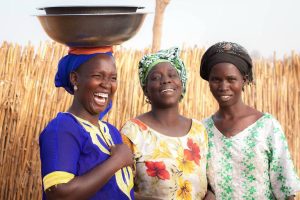- Western Africa Water & Sanitation Program
- Saré Pathé Bouya CEM Latrine Project - Senegal
- Bafamgoum Well Project - Cameroon
- Salemata Region Latrine Project Kedougou - Senegal
- Sinende Commune Well Project - Benin
- Nsuo Ase Water System Project - Ghana
- Burji District Borehole Project - Ethiopia
- Emmanuel School Water and Sanitation Project - Kenya
- Missirah Dantila Borehole Project - Senegal
- Thiara Middle School Latrine Project - Senegal
- Xol Xol Merina School Latrine & Handwashing Station Project - Senegal
- Djelibakoro Well Project - Guinea
- Fitaba Garden Water Basin Project - Senegal
- Kedougou Community Well Project - Senegal
- Njie Kunda Latrine Project - The Gambia
- Sintet Health Center Solar Pump Project - The Gambia
- Ifangni School Water System Project - Benin
- Kua Training Center Borehole Project - Ghana
- Primary School of Diakhaba Well Improvement Project - Senegal
Water Charity and the National Peace Corps Association (NPCA) ![]() have begun a new program to replicate the ongoing success of our East Africa Water & Sanitation Program in Western Africa. It involves the implementation of dozens of water, sanitation, public health, and environmental projects in a number of West African nations.
have begun a new program to replicate the ongoing success of our East Africa Water & Sanitation Program in Western Africa. It involves the implementation of dozens of water, sanitation, public health, and environmental projects in a number of West African nations.
The initial countries included in the program were:
Senegal, The Gambia, Burkina Faso, Ghana, Togo, Benin, Morocco, Cameroon, Sierra Leone and Liberia. Guinea was later added.
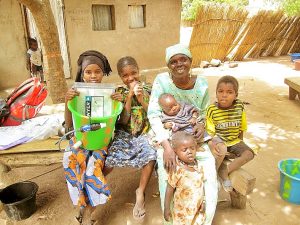 It is likely that we will add other countries in the region to the program as it expands, and as security can be ensured..
It is likely that we will add other countries in the region to the program as it expands, and as security can be ensured..
This program is open-ended, and will consist of individual projects both large and small. These will include our “normal” projects in the region, as well as even larger, more comprehensive efforts.
Project planning is well underway, and work on the ground has begun on several projects. Individual projects will be phased in for implementation as planning for each is completed.
The Partnership
Water Charity is a 501(c)(3) nonprofit, established in 2008 and headquartered in California, that does water, sanitation, public health, and environmental projects around the world. It has implemented around 2,000 projects in 65 countries to date, about 95% of them under the direction of Peace Corps Volunteers (PCVs) and Returned Peace Corps Volunteers (RPCVs).
The National Peace Corps Association (NPCA) was founded in 1979 and is headquartered in Washington, D.C. with a mission to championing a lifelong commitment to Peace Corps values. The goals of NPCA are to help the Peace Corps be the best that it can be and help Returned Peace Corps Volunteers (RPCVs) and RPCV groups thrive.
Averill Strasser, RPCV, Co-Founder and COO of Water Charity, and Glen Blumhorst, President of National Peace Corps Association, are working together in the implementation of this program.
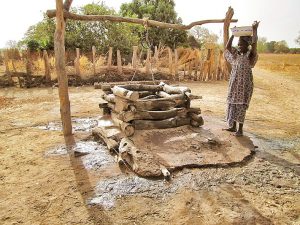 Methodology
Methodology
The program, along with much of the work done by Water Charity, follows a unique methodology of utilizing the services of PCVs and RPCVs for project management. This imparts a level of cost-effectiveness that is many times that achieved by other organizations doing similar work. In this way, travel and administrative expense are eliminated, as there are capable, local-language-speaking, highly-motivated PCVs already living in the villages where the projects are taking place.
Most often, these projects arise out of the relationship between the PCVs and their host communities, and an effort to bring these villages together on their water & sanitation issues. This generally involves the formation of a local water committee, the use of entirely local labor, local materials sourcing, and a real commitment on the part of the people who benefit from the projects to monitor & maintain them.
This is a sustainable and successful model in which the community is invested in the outcome and members are motivated to preserve the improvements. With the community contributing materials, labor, and money, villagers have a sense of pride and ownership, leading to long-term success.
Within the 10-country program area, individual projects will be planned and implemented one-by-one, rather than following an imposed and fully-developed plan. The model is based on the premise that there is great need in the entire program area, and the most cost-effective way to save lives and prevent and cure illness is to quickly address those needs in the order in which they arise organically from the communities.
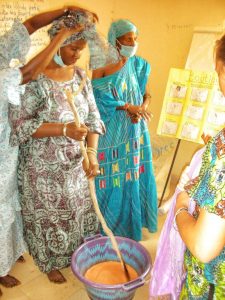 Incorporation of Peace Corps Volunteers
Incorporation of Peace Corps Volunteers
The major portion of the on-the-ground administration of projects will be carried out under the direction of serving PCVs. These are all college graduates who have been trained in country, and possess language, technical, social, and community development skills.
There are about 7,000 PCVs at any given time worldwide, with about 1,200 in the designated program area. These PCVs live and work with members of the community, and, in the implementation of our WATSAN projects, they are involved in all stages of community organization, project conceptualization, planning, implementation, completion, and evaluation.
Where there are opportunities to aggregate projects that are being done in close geographic and temporal proximity, we aim to get PCVs working together and offering assistance to each other in planning and execution. This has benefits of economy of scale, camaraderie, continuity, sustainability, and ease of evaluation.
All in all, Water Charity projects serve to strengthen the Peace Corps, and allow PCVs to contribute meaningfully to the health and wellbeing of their host villages. Projects are often secondary to the primary program assignment of a PCV. However, such projects always add to the value of the Peace Corps service by bringing needed resources to the village, and creating tangible community development results.
The Role of Returned Peace Corps Volunteers
Approximately 215,000 people have served as PCVs since the Peace Corps was started about 54 years ago. They represent an important and valuable resource to assist in the role of community development in the world.
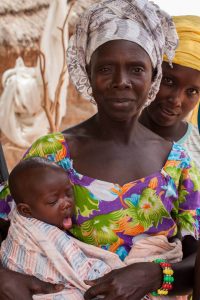 NPCA is a partner of Peace Corps, and is the designated organization to represent all RPCVs, as well as to amplify the power of the Peace Corps.
NPCA is a partner of Peace Corps, and is the designated organization to represent all RPCVs, as well as to amplify the power of the Peace Corps.
In the past 7 years, many RPCVs have worked with Water Charity to directly implement projects. RPCVs return to their country of service because of a lifelong commitment, and bring with them their prior skills, education, and training.
RPCVs will continue to directly implement projects, but will also be utilized to provide training and support to serving PCVs to assist them in all phases of their projects.
Types of Projects
All projects fall under the categories of water, sanitation, public health,and environment, and many of these serve double duty, in that they also cover multiple areas like education, disaster relief, drought & famine aid, as well as the new Let Girls Learn designation. Running water to a school that never had access to water, and building a number of bathrooms, water fountains, and handwashing stations, for instance, is a water, sanitation, education and women’s empowerment project all in one!
Typical projects will be community water systems, wells, pumps, tanks, small reservoirs, rainwater catchment systems, irrigation systems, water purification installations, latrines, and handwashing stations.
All projects will require the community participation of labor, materials, and/or money, to the extent that the community is able to contribute, often as much as 25% of the project cost.
The local water committee, in some cases, may decide to impose small fees on the villagers for use of newly-created water facilities, such that there will be funds available for maintenance, repair, and replacement when the need arises. These fees will always be affordable for all residents,
Water Charity is prepared to return to a community and aid the residents in repairs or expansion when local resources do not permit such work without assistance.
All projects have community training and education components to teach villagers the technologies employed, the use, maintenance, and repairs of the improvements, as well as any hygiene and public health concepts that might aid them.
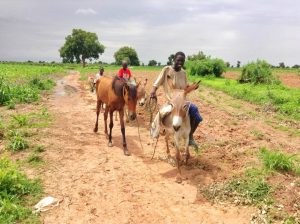 Where the skilled labor needed to complete a job doesn’t exist, Water Charity is pleased to engage in job training, whereby technical skills are imparted to locals looking for work, and thus enabling them to form small businesses which allows them to utilize the acquired knowledge, and apply it in other communities. This creates a rather profound “ripple effect” to our projects, whereby the new (or even pre-existing) businesses of the skilled laborers can proliferate the technology in nearby areas while creating employment and economic incentives.
Where the skilled labor needed to complete a job doesn’t exist, Water Charity is pleased to engage in job training, whereby technical skills are imparted to locals looking for work, and thus enabling them to form small businesses which allows them to utilize the acquired knowledge, and apply it in other communities. This creates a rather profound “ripple effect” to our projects, whereby the new (or even pre-existing) businesses of the skilled laborers can proliferate the technology in nearby areas while creating employment and economic incentives.
Where feasible, tools are left behind after completion of our projects to serve in this effort. In this way, many Water Charity projects have spawned dozens of other similar projects in a given area, without us having to be directly involved… and while boosting the local economy to boot.
Sustainability is ensured by serving PCVs and their replacements, who visit the project sites at intervals after completion and facilitate needed repairs and improvements. Local water committees and skilled laborer businesses also contribute to the overall sustainability. Water Charity projects have an outstanding success rate because of these elements, and considerably greater longevity than comparable projects, while being an order of magnitude cheaper to implement in most cases.
Implementation
At the bottom of the page is a listing of projects that have recently been started under the program. The list will be updated as new projects come on line. A little triangle next to the project name indicates that it is already completed and a conclusion page has been posted and nested underneath the original project page.
Summary
The program offers unmatched cost-effectiveness to implement vital projects using appropriate technology. It benefits from our unique model and past knowledge of and experience in the chosen countries. It eliminates the expenses of travel, in-country headquarters, and administrative costs, and allows for most project dollars to be directed to materials and skilled labor.
Donation to this program is a sure-fire way to aid and assist a large number of people with great water and sanitation needs, speedily and efficiently.
This program is targeted for funding of $2,200,000 over 3 years, rolled out as follows:
- $440,000 for Year 1
- $660,000 for Year 2
- $1,100,000 for Year 3
